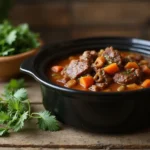Nothing beats the satisfying combination of tender beef and rich oyster sauce when you’re craving authentic Chinese takeout flavors at home. This classic stir-fry dish delivers restaurant-quality results in just minutes, making it perfect for busy weeknight dinners or impressive weekend meals.
We’ve perfected this beef with oyster sauce recipe to ensure every bite features perfectly cooked beef strips coated in a glossy, savory sauce that’s both sweet and umami-packed. The secret lies in the simple marinade and high-heat cooking technique that locks in the meat’s natural juices while creating those coveted caramelized edges.
What makes this dish truly special is its versatility – serve it over steamed rice for a complete meal, or pair it with your favorite vegetables for extra nutrition. With ingredients you likely already have in your pantry, this recipe transforms ordinary beef into an extraordinary dinner that’ll have everyone asking for seconds.
Ingredients
We’ve organized our ingredients into three simple categories to make preparation seamless and efficient. These common pantry staples and fresh ingredients combine to create restaurant-quality flavors at home.
For the Beef Marinade
- 1 pound beef sirloin or flank steak, sliced into thin strips against the grain
- 2 tablespoons soy sauce
- 1 tablespoon cornstarch
- 1 teaspoon sesame oil
- 1/2 teaspoon black pepper
- 1 teaspoon sugar
For the Stir-Fry
- 3 tablespoons vegetable oil, divided
- 3 cloves garlic, minced
- 1 tablespoon fresh ginger, minced
- 1 medium onion, sliced
- 1 bell pepper, sliced into strips
- 2 green onions, chopped
- 1 tablespoon sesame seeds for garnish
For the Oyster Sauce Mixture
- 3 tablespoons oyster sauce
- 2 tablespoons soy sauce
- 1 tablespoon rice wine or dry sherry
- 1 teaspoon cornstarch
- 1/2 teaspoon sugar
- 1/4 cup beef broth or water
- 1 teaspoon sesame oil
Equipment Needed
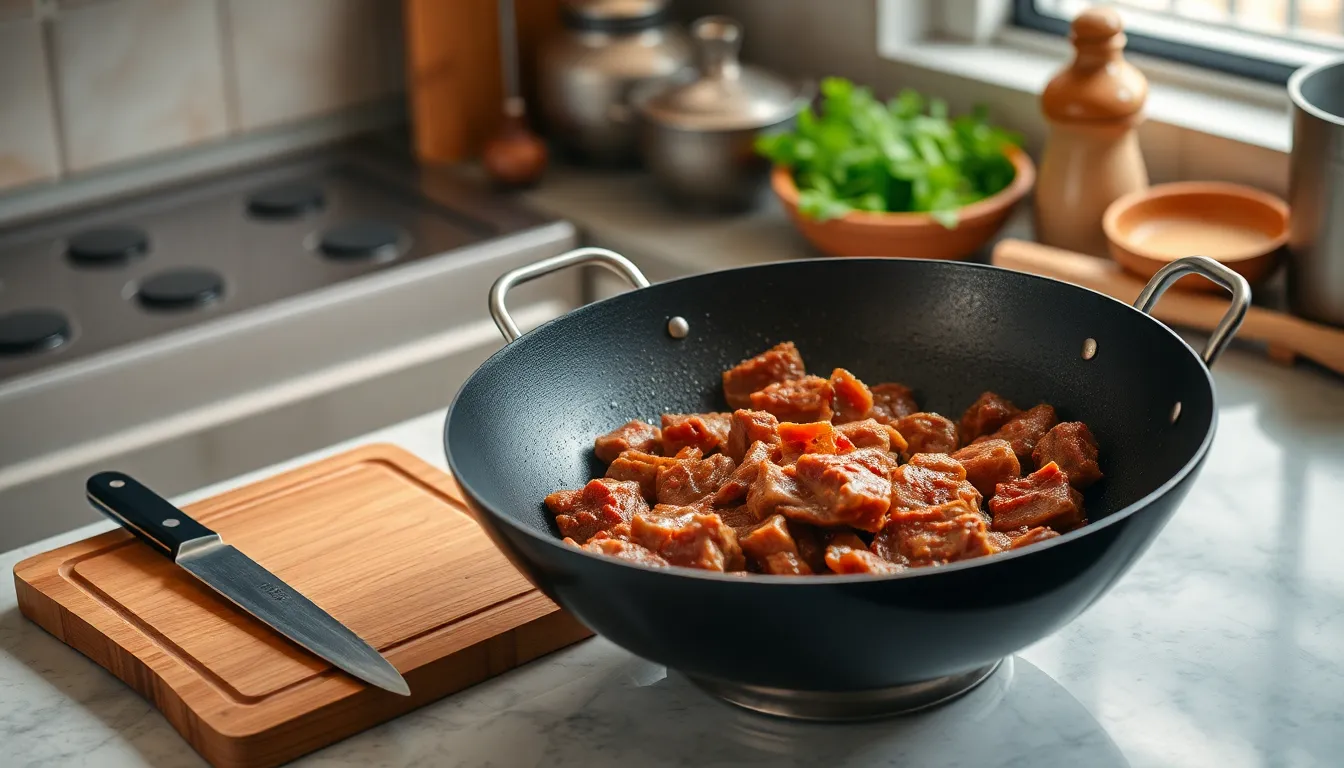
Creating the perfect beef with oyster sauce requires the right tools to achieve restaurant-quality results at home. We’ve found that having proper equipment makes the difference between a good stir-fry and an exceptional one.
Wok or Large Skillet serves as our primary cooking vessel for this dish. A traditional wok remains the preferred choice due to its high sides and sloping shape that allow even heat distribution and fast cooking. The curved design helps ingredients move freely during stir-frying while maintaining consistent temperatures. Large skillets or frying pans work as excellent substitutes when a wok isn’t available.
Sharp Knife becomes essential for achieving uniformly thin beef slices that ensure tenderness and even cooking throughout. We recommend using a well-maintained chef’s knife or cleaver that can handle precise cuts through the meat fibers.
Cutting Board provides the stable surface we need for safely preparing our beef and other ingredients. Choose a board large enough to accommodate all your prep work without overcrowding.
Tongs or Spatula help us stir and toss ingredients effectively in the hot wok. These tools promote even cooking and proper caramelization while preventing ingredients from sticking or burning. Wooden or heat-resistant silicone options work best for non-stick surfaces.
| Equipment | Purpose | Alternative |
|---|---|---|
| Wok | Primary cooking vessel with optimal heat distribution | Large skillet or frying pan |
| Sharp knife | Uniform beef slicing for tenderness | Chef’s knife or cleaver |
| Cutting board | Stable prep surface | Any large cutting surface |
| Tongs/Spatula | Even stirring and tossing | Wooden spoon or heat-resistant utensil |
Having these fundamental tools ready before we start cooking ensures smooth preparation and helps us achieve that perfect texture and flavor balance that makes beef with oyster sauce so irresistible.
Prep Work
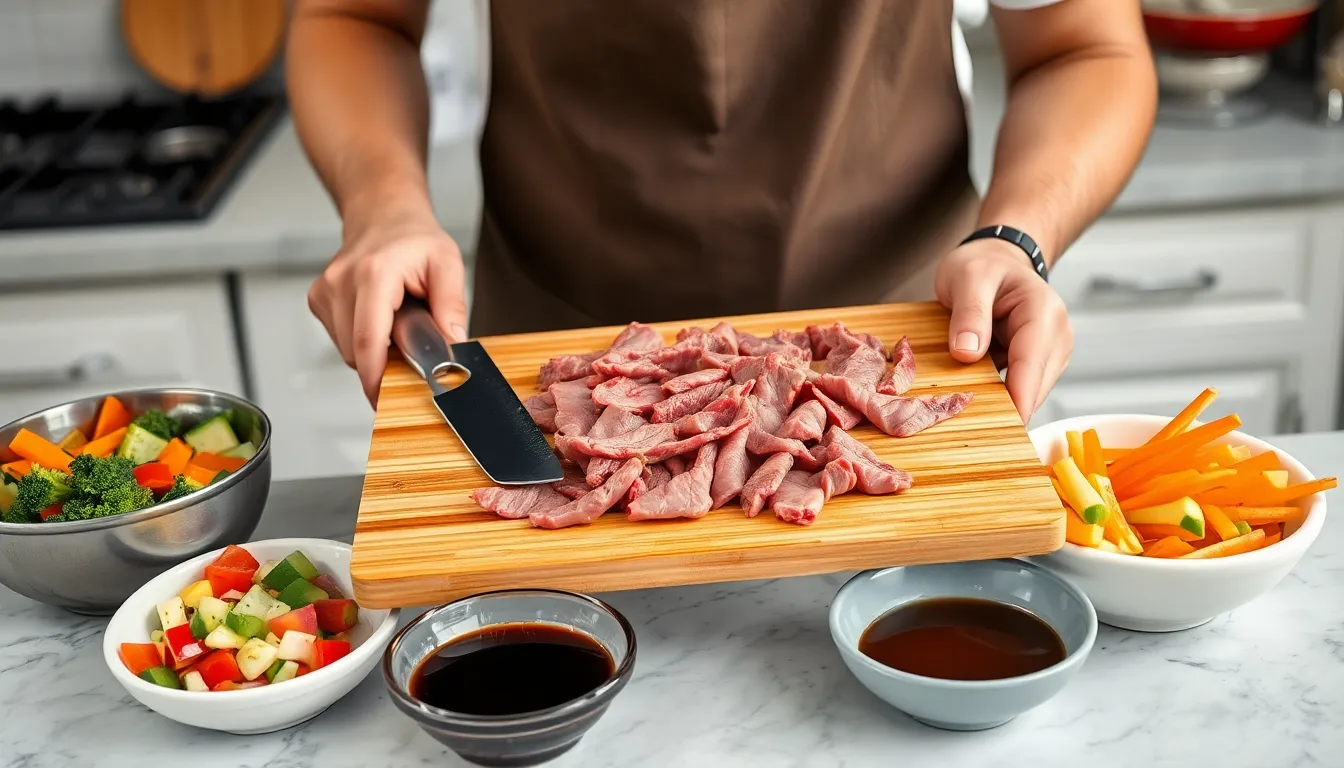
Proper preparation is essential for achieving that perfect restaurant-style beef with oyster sauce. We’ll organize our ingredients and complete all prep work before heating the wok to ensure smooth cooking.
Preparing the Beef
We start by slicing our beef thinly against the grain, cutting pieces about 5 mm thick and 5 cm long for even cooking and optimal tenderness. This cutting technique breaks down the muscle fibers and creates the perfect texture.
Next, we marinate the beef with soy sauce, Shao Xing wine, sugar, and cornstarch. Adding baking soda to the marinade is optional but helps tenderize tougher cuts. We let the beef sit for at least 10 minutes to absorb all the flavors and achieve maximum tenderness.
The cornstarch in our marinade creates a protective coating that keeps the beef juicy during high-heat cooking. We ensure each piece is well coated before setting it aside.
Preparing the Vegetables
We prepare our aromatics by mincing the garlic and slicing the ginger into thin pieces for quick cooking. Fresh garlic and ginger provide the foundation of flavor for our stir fry.
Our onions get chopped into bite-sized pieces that will cook evenly with the beef. We also prepare any additional vegetables like asparagus or choy sum by cutting them into uniform pieces.
For vegetables with different cooking times, we separate the stems from the leaves. Tougher stems go into the wok first, while delicate leafy parts get added at the end to prevent overcooking.
Making the Sauce
We whisk together oyster sauce with soy sauce, a touch of sugar, and sometimes water or broth in a small bowl. This sauce mixture becomes the glossy coating that makes our beef irresistible.
The sauce should be smooth and well combined before we start cooking. We often add a small amount of cornstarch to help thicken the sauce and create that signature glossy finish.
Having our sauce ready before we begin stir frying ensures we can work quickly once the wok gets hot. We keep the bowl nearby for easy access during the final cooking stage.
Instructions
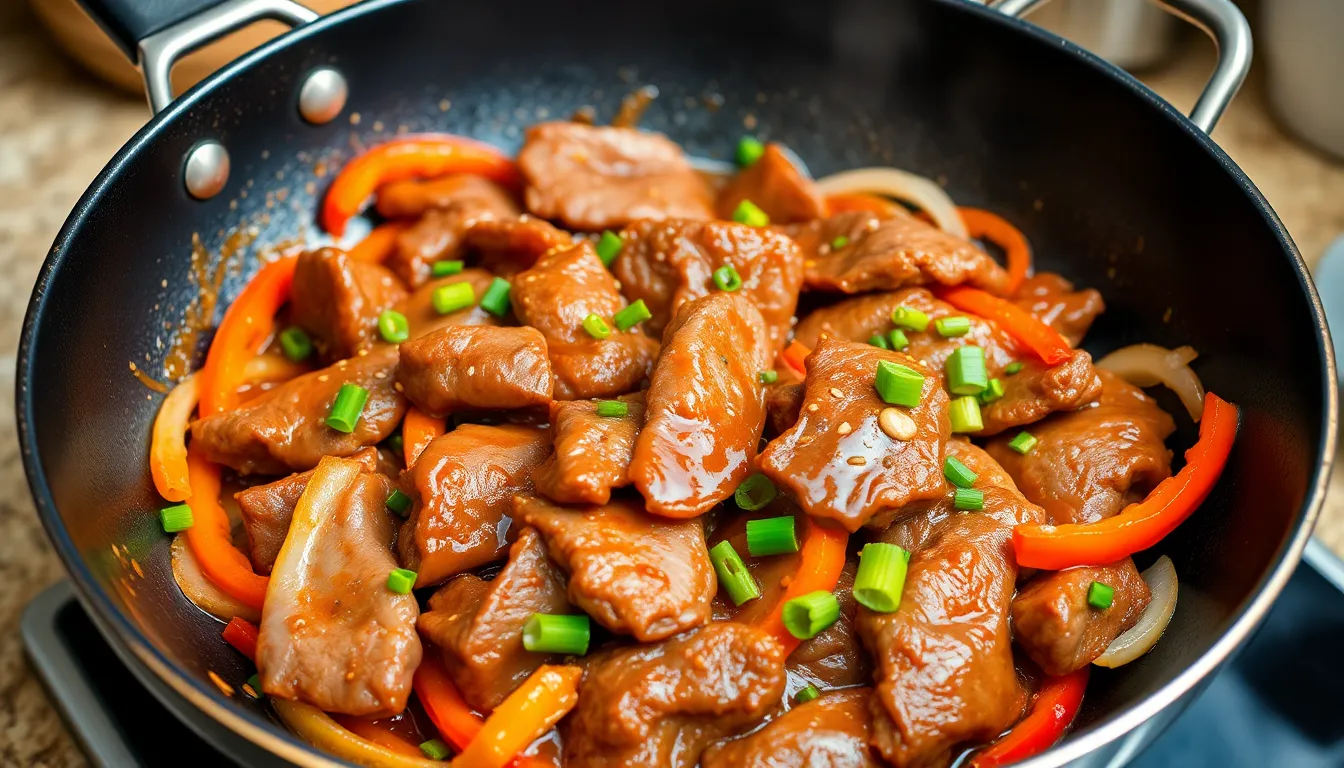
We’ll walk through the complete cooking process step by step to create tender beef with a glossy oyster sauce coating. This method ensures restaurant-quality results every time.
Marinating the Beef
Place the sliced beef in a medium bowl and add the soy sauce, cornstarch, sesame oil, black pepper, and sugar. Mix thoroughly with your hands or a spoon until every piece is evenly coated with the marinade. Allow the beef to rest for 10-15 minutes at room temperature while you prepare the remaining ingredients. This marinating time lets the cornstarch create a protective coating that keeps the meat tender during the high-heat cooking process.
Stir-Frying the Beef
Heat your wok or large skillet over medium-high heat until it begins to smoke slightly. Add 2 tablespoons of vegetable oil and swirl to coat the bottom of the pan. Carefully add the marinated beef in a single layer without overcrowding the pan. Let the beef sear undisturbed for 1-2 minutes until the bottom develops a light golden crust. Stir-fry the beef for an additional 2-3 minutes until just cooked through and lightly browned on all sides. Transfer the beef to a clean plate and set aside.
Adding Vegetables and Sauce
Return the same wok to medium-high heat and add the remaining tablespoon of oil if needed. Add the minced garlic and ginger, stirring constantly for 30 seconds until fragrant. Toss in the sliced onion and bell pepper, stir-frying for 1-2 minutes until the vegetables are slightly tender but still crisp. Pour the prepared oyster sauce mixture into the center of the wok and let it bubble for a few seconds. Stir everything together quickly to coat the vegetables evenly with the sauce.
Final Assembly
Return the cooked beef to the wok along with any accumulated juices from the plate. Toss everything together vigorously for 1-2 minutes until the beef and vegetables are evenly coated with the glossy sauce. The sauce should thicken slightly and cling to all the ingredients. Remove from heat immediately and sprinkle with sliced green onions and sesame seeds before serving over steamed rice.
Cooking Tips for Perfect Results
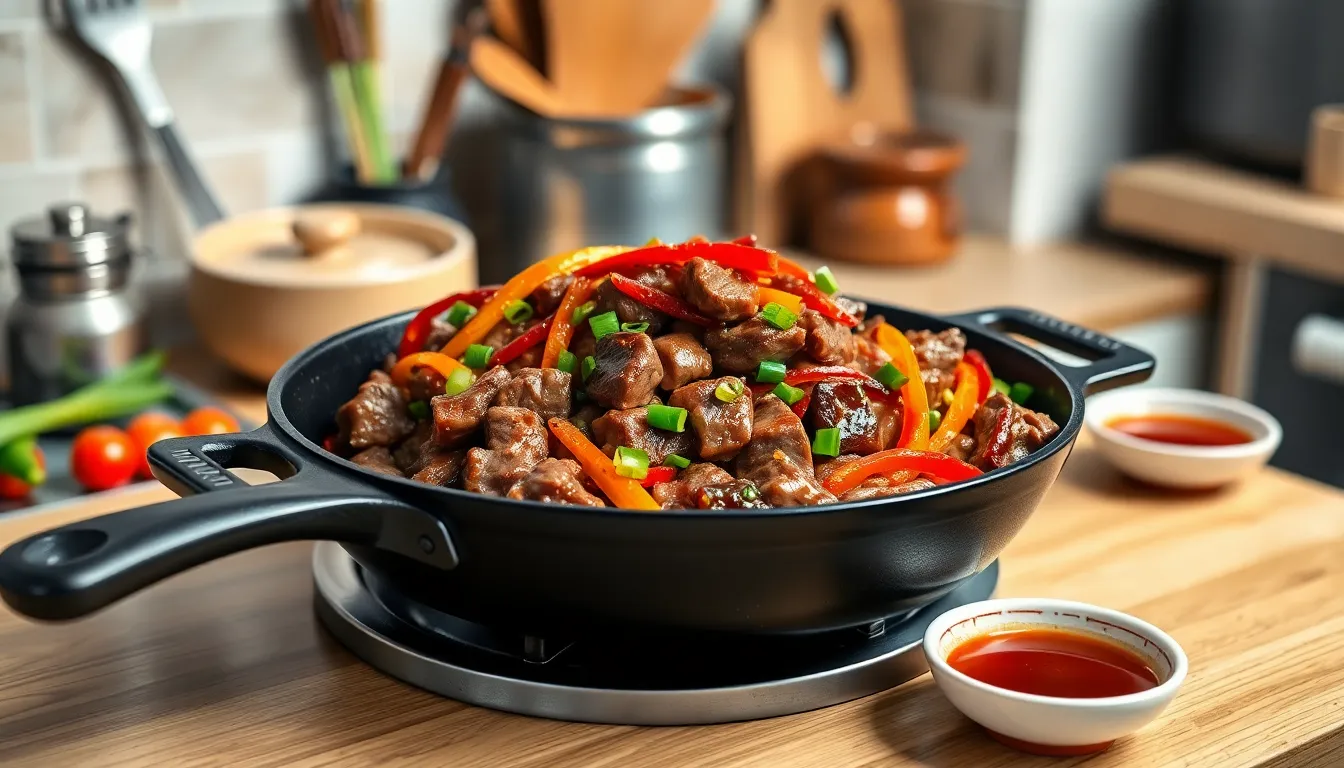
Master the Art of Beef Slicing
We recommend slicing your beef thinly against the grain at approximately 1/8 inch thickness for maximum tenderness. This technique breaks down the muscle fibers and ensures each bite melts in your mouth. Choose premium cuts like top sirloin cap, flank steak, ranch steak, or flat iron for the best results.
Perfect Your Marinade Technique
Allow your beef to marinate for at least 5 to 10 minutes to properly tenderize and infuse flavor. We combine dark soy sauce, Chinese cooking wine like Shao Xing wine, egg white, cornstarch, and sugar for our marinade. Adding a pinch of baking soda helps break down proteins for extra tenderness.
Apply the Velveting Method
This traditional Chinese technique keeps beef incredibly juicy and tender. We coat the marinated beef in our mixture and quickly stir fry it in very hot oil until it just changes color. Remove the beef before it fully cooks to prevent toughness.
Control Your Heat and Timing
High heat cooking prevents beef from becoming dry and overcooked. We sear the beef for exactly 1.5 minutes until it changes color but remains slightly underdone. Quick stir frying preserves the meat’s natural juices and creates that perfect restaurant texture.
Prepare Your Sauce in Advance
Mix your sauce ingredients before you start cooking since stir frying happens quickly. We whisk together oyster sauce, soy sauce, sugar, cornstarch, water, and freshly ground black pepper until completely smooth. Having this ready prevents burning while you search for ingredients.
Cook Components Separately
We always sear the beef first, then remove it from the pan before cooking aromatics and vegetables. This prevents overcooking and maintains the distinct textures that make this dish special. Return the beef only at the final stage for quick coating with sauce.
Balance Your Flavors
Adjust the sugar and soy sauce ratio to achieve the perfect sweet and salty balance. We taste our sauce mixture before adding it to the pan and make adjustments as needed. Every brand of oyster sauce varies in saltiness and sweetness.
Serve at Peak Temperature
Present this dish immediately while everything remains hot and the sauce stays glossy. We recommend using a preheated serving platter to maintain temperature. Some restaurants serve beef with oyster sauce in small cast iron pots over fondue sets to keep it sizzling at the table.
Serving Suggestions
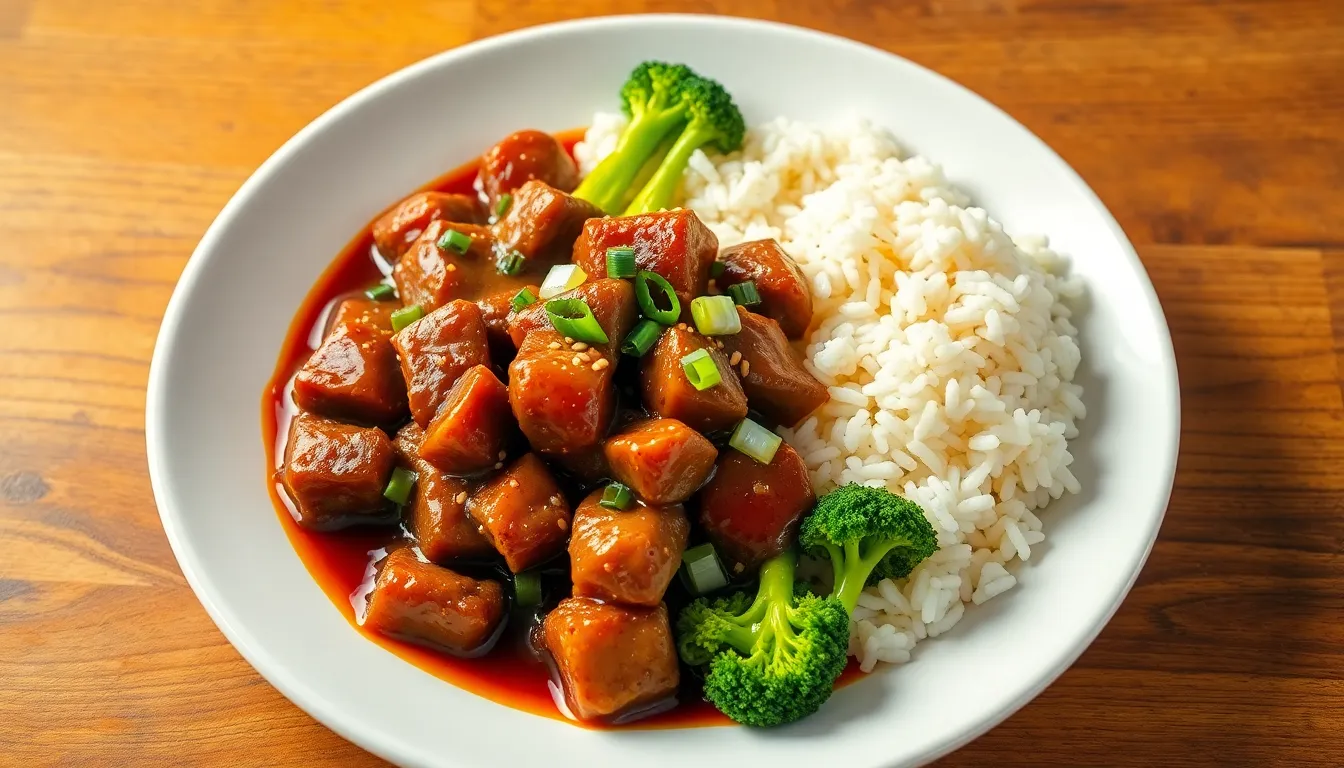
We recommend serving our beef with oyster sauce immediately while it’s hot and glossy to capture the peak flavors and textures. Steamed jasmine rice makes the perfect foundation for this savory dish as it absorbs the rich oyster sauce without competing with the bold flavors. The neutral taste of the rice allows the umami-packed sauce to shine through every bite.
For variety we can pair this stir-fry with egg fried rice which adds extra protein and a slightly different texture profile to complement the tender beef strips. Plain noodles work beautifully as well creating a heartier meal that satisfies larger appetites. Lo mein or chow mein noodles absorb the sauce exceptionally well while providing a satisfying chewiness that contrasts with the beef’s tenderness.
We find that adding simple steamed or stir-fried greens creates a well-balanced meal that enhances both nutrition and visual appeal. Blanched broccoli or bok choy provide crisp textures and fresh flavors that cut through the rich sauce. These vegetables also add vibrant colors that make the dish more visually appealing on the plate.
Our beef with oyster sauce pairs wonderfully with other Chinese dishes for family-style dining. Consider serving alongside spring rolls or pot stickers as appetizers to create a complete Chinese feast. Hot and sour soup or wonton soup make excellent starters that prepare the palate for the main course.
Temperature matters significantly when serving this dish so we always ensure our plates are warmed beforehand. The contrast between the hot beef and sauce against room temperature plates can cause the sauce to cool too quickly and lose its glossy appearance. Garnishing with fresh green onions and sesame seeds just before serving adds both color and extra flavor notes that enhance the overall presentation.
Storage and Reheating Instructions
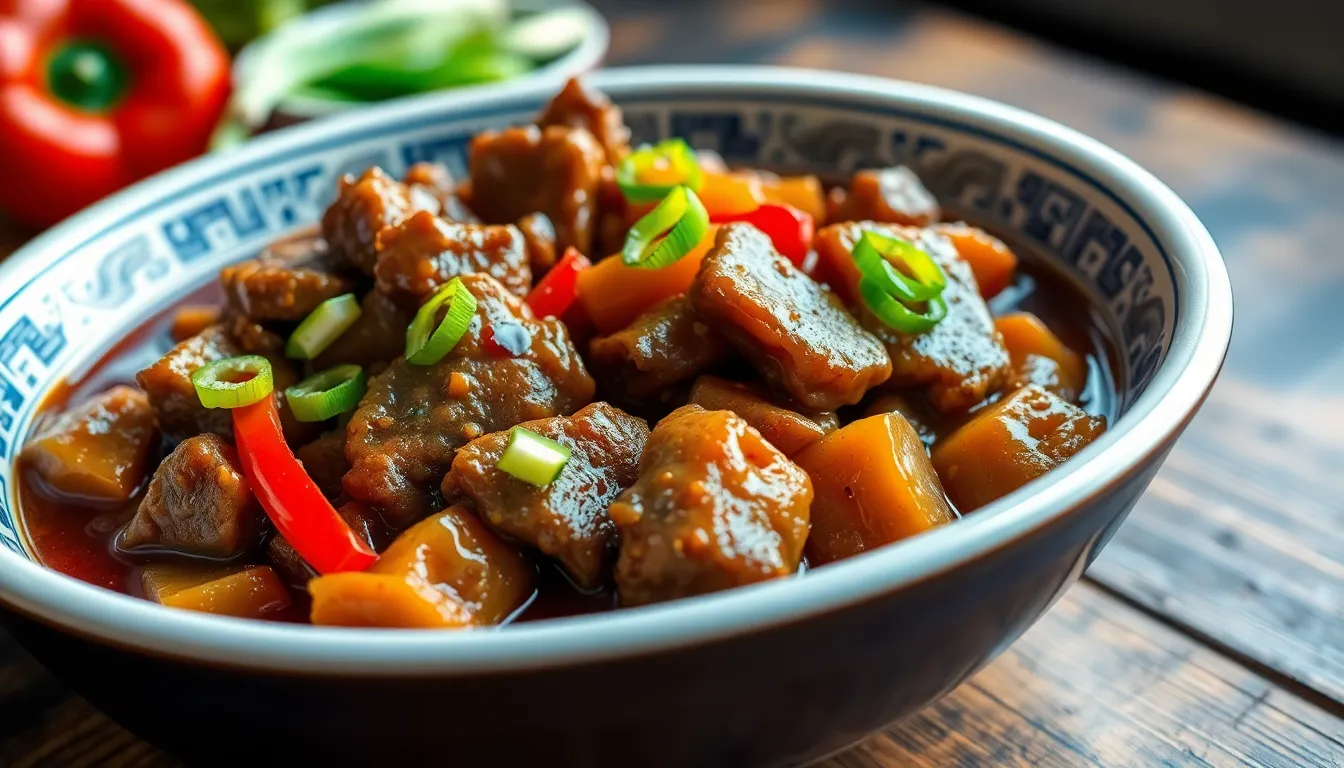
Our beef with oyster sauce tastes best when served fresh and hot, but we understand that leftovers are sometimes inevitable. Proper storage techniques help maintain the dish’s flavor and texture for future enjoyment.
Storing Leftovers
We recommend allowing the beef with oyster sauce to cool completely at room temperature before storage. Never leave the dish out for more than 2 hours to prevent bacterial growth. Transfer the cooled stir-fry into an airtight container to preserve freshness and prevent odors from mixing with other refrigerated foods.
Our cooked beef with oyster sauce maintains its quality in the refrigerator for up to 3-4 days when stored properly. We suggest labeling the container with the date to track freshness and ensure food safety.
| Storage Method | Temperature | Duration |
|---|---|---|
| Refrigerator | 40°F or below | 3-4 days |
| Room Temperature | Not recommended | Maximum 2 hours |
Reheating for Best Results
We strongly recommend reheating this dish gently in a pan over medium-low heat rather than using a microwave. The gentle stovetop method prevents the beef from becoming tough and chewy while maintaining the sauce’s proper consistency.
Add a splash of water or beef broth to the pan if the oyster sauce has thickened too much during storage. We find that stirring occasionally during reheating ensures even heat distribution and prevents sticking. The dish is ready when heated through completely, which typically takes 3-5 minutes depending on the portion size.
Microwave reheating tends to toughen the beef and create uneven heating, so we avoid this method whenever possible. The high heat from microwaving can break down the tender texture we worked so hard to achieve during the initial cooking process.
Maintaining Quality During Storage
We notice that the cornstarch coating on the beef helps maintain moisture even after refrigeration. The oyster sauce mixture may separate slightly during storage, but gentle stirring during reheating redistributes the flavors evenly throughout the dish.
Fresh vegetables like bell peppers and green onions may lose some crispness after storage, but they still contribute valuable flavor to the reheated dish. We recommend adding a few fresh green onion slices as garnish when serving leftovers to restore some of that original vibrant presentation.
Recipe Variations
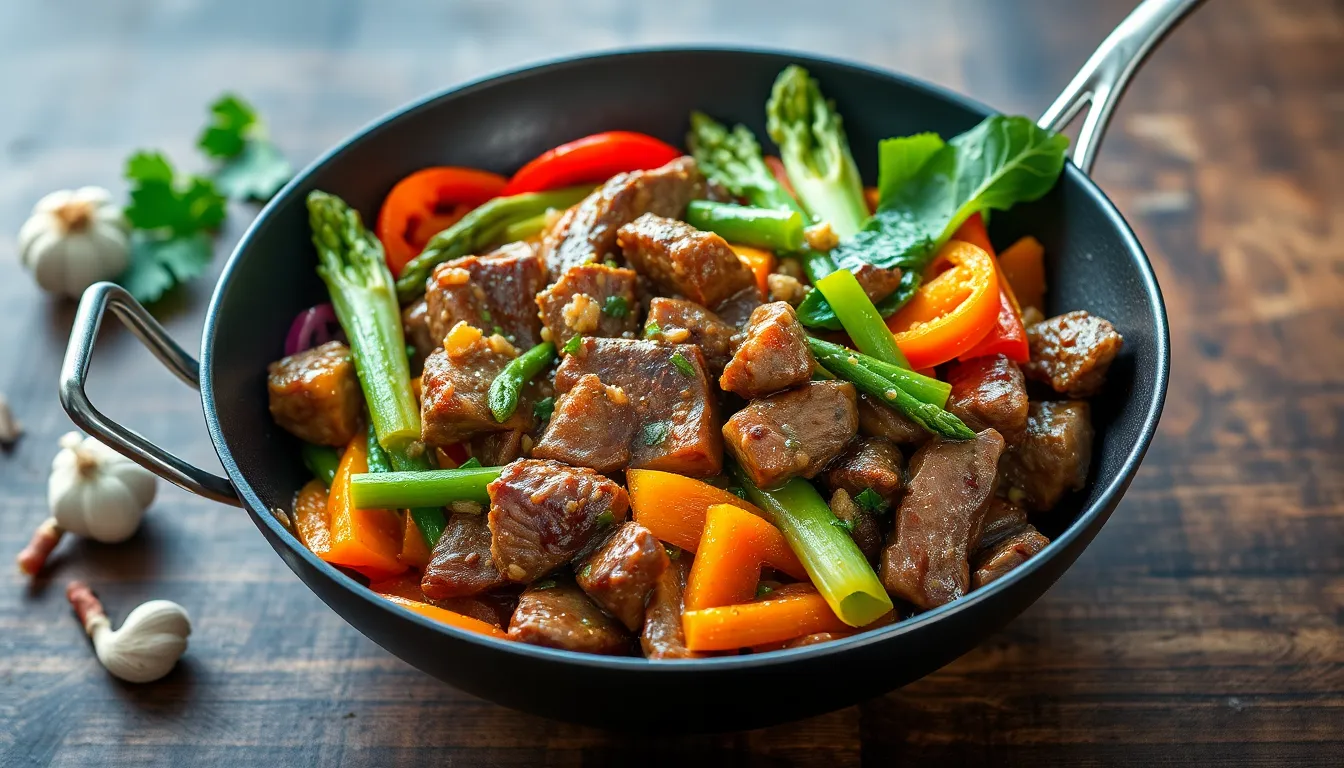
We love how versatile beef with oyster sauce can be when adapting to different ingredients and dietary preferences. These variations allow you to customize the dish while maintaining that signature savory umami flavor profile.
Different Vegetable Options
We recommend choosing vegetables based on seasonality and your texture preferences. Asparagus pairs beautifully with the beef for a delicate spring-like feel when combined with garlic and ginger aromatics. Bok choy creates a heartier option that adds nutritious greens and crisp texture to every bite.
Broccoli works exceptionally well in Chinese-American style preparations and provides excellent nutritional value. Bell peppers add vibrant color and sweet crunch that complements the savory oyster sauce perfectly. We suggest cutting all vegetables uniformly to ensure even cooking and optimal texture throughout the dish.
For best results, separate tougher vegetable stems from delicate leaves during preparation. This technique prevents overcooking and maintains the ideal bite texture that makes restaurant-style stir-fries so appealing.
Protein Substitutions
We find that several protein alternatives work wonderfully with oyster sauce while maintaining the dish’s authentic flavor profile. Chicken breast or thighs provide a lighter option that absorbs the marinade beautifully and costs less than premium beef cuts.
Pork tenderloin or shoulder offers rich flavor that pairs exceptionally well with the umami-rich sauce. Different beef cuts like flank, skirt, hanger, or flap meat each bring unique textures and flavor intensities to the final dish.
For dietary flexibility, we recommend tofu as an excellent plant-based alternative that soaks up the oyster sauce marinade effectively. Seafood options like shrimp or scallops create elegant variations while maintaining quick cooking times essential for proper stir-fry technique.
Each protein substitution requires slight timing adjustments during cooking, but the core preparation method remains consistent across all variations.
Conclusion
This beef with oyster sauce recipe brings restaurant-quality flavors straight to your kitchen with minimal effort and maximum taste. We’ve covered everything from proper beef preparation to achieving that perfect glossy sauce that makes this dish so irresistible.
The beauty of this recipe lies in its flexibility – whether you’re cooking for a busy weeknight dinner or entertaining guests you can easily adapt it to your preferences. With the right techniques and our helpful tips you’ll create a dish that rivals your favorite Chinese restaurant.
Now it’s time to fire up that wok and start cooking. We’re confident you’ll love how this savory aromatic stir-fry transforms simple ingredients into something truly special.
Frequently Asked Questions
What cut of beef is best for oyster sauce stir-fry?
Beef sirloin or flank steak work best for this recipe. These cuts are tender when sliced thinly against the grain and cook quickly at high heat. The key is cutting the beef into uniform strips, about 1/4-inch thick, which ensures even cooking and prevents toughness.
How long should I marinate the beef?
Marinate the beef for at least 15-30 minutes to allow the flavors to penetrate and the cornstarch to create a protective coating. For deeper flavor, you can marinate for up to 2 hours in the refrigerator. The cornstarch helps keep the beef tender during high-heat cooking.
Can I make this recipe without a wok?
Yes, a large skillet or heavy-bottomed pan works well as a substitute for a wok. The key is using high heat and ensuring your pan is large enough to prevent overcrowding. This allows the beef to sear properly rather than steam, achieving that authentic stir-fry texture.
What vegetables can I add to this stir-fry?
Popular additions include bell peppers, broccoli, bok choy, asparagus, and snap peas. Cut vegetables uniformly for even cooking and add harder vegetables first, followed by softer ones. Separate tough stems from delicate leaves to prevent overcooking and maintain proper texture.
How do I store and reheat leftovers?
Store cooled leftovers in an airtight container in the refrigerator for 3-4 days. Reheat in a pan over medium-low heat, stirring gently to maintain the beef’s tenderness and sauce consistency. Avoid microwaving as it can make the beef tough and rubbery.
Can I substitute the oyster sauce?
While oyster sauce provides the dish’s signature flavor, you can substitute with hoisin sauce mixed with soy sauce, or use mushroom oyster sauce for a vegetarian option. The flavor will be slightly different but still delicious. Keep the same proportions in the sauce mixture.
What’s the best rice to serve with this dish?
Steamed jasmine rice is ideal as it absorbs the rich oyster sauce beautifully. You can also serve it with egg fried rice or plain white rice. For variety, try it over noodles like lo mein or chow mein for a different texture experience.
How do I prevent the beef from becoming tough?
Slice the beef against the grain, marinate with cornstarch, and cook over high heat quickly. Don’t overcook the beef – it should be just cooked through. The velveting technique using cornstarch creates a protective coating that keeps the meat tender and juicy.

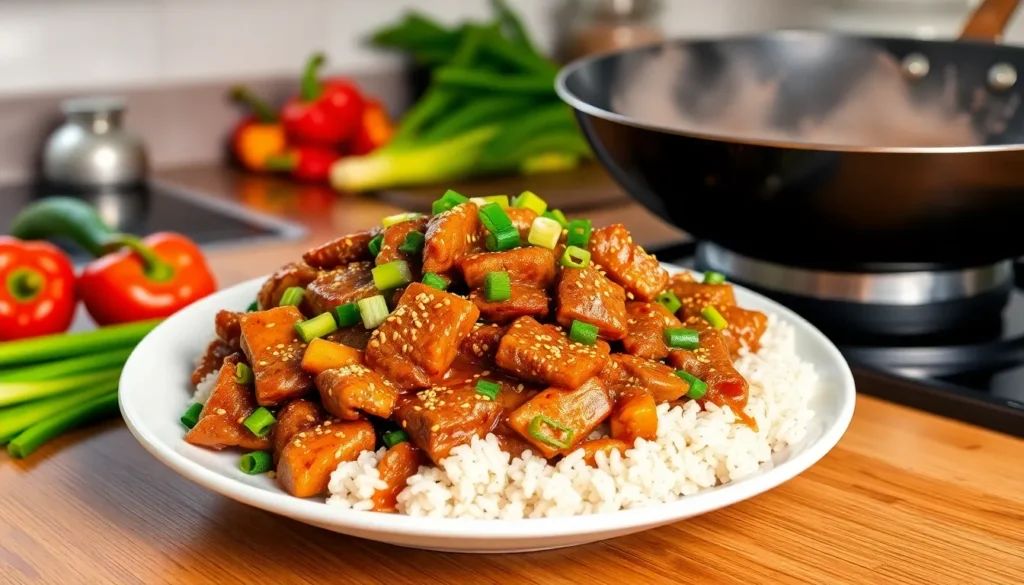
















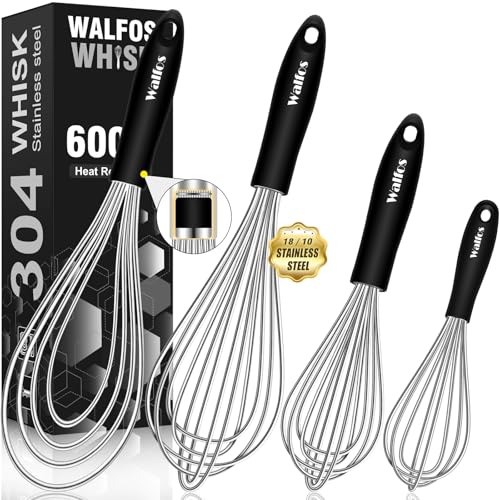



![100% Compostable Paper Plates, Heavy Duty Disposable Plates [125-Pack] 9](https://m.media-amazon.com/images/I/41i7r-FompL._SL500_.jpg)





